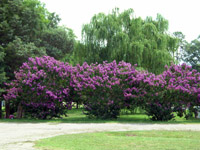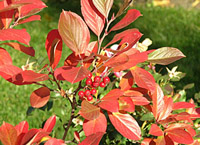Climate change was on my mind when I recently visited my community garden during weather that felt a lot more like spring than midwinter. I should not be surprised that in these mild temperatures the ornamental garden has slowed down but not ceased growing completely. The basal leaves of anemones, asters, goldenrod, and monkshood are visible as they gather energy for the coming season. Remarkably, the buds on my fall-blooming witch hazel continue to open. Now that snowdrops and spring witch hazels have started blooming, the end of the 2007 growing season has met the beginning of the 2008 season. In my garden this has occurred only over the past three years, some of the warmest on record. This is definitely a sign of change.
The mild temperatures were also evident in the edible garden. The loose, moist soil made quick work of digging sunchoke (Jerusalem artichoke) tubers. I brought the pickax but I only needed the garden fork to lift the gnarly tubers from the ground. My great-grandmother used to grow this native root crop. Somehow, I feel closer to her when I harvest sunchokes. But Grandmother Ruth would never have expected to dig them in the middle of winter.
What's going on? The warm days are nice. Sunny afternoon walks in February are a treat. It's amazing to get flowers and food from a Chicago garden at this time of year. Is this just an anomaly or the effects of global warming? Will winters continue to moderate? Is Chicago destined to have a nearly continuous gardening year like San Antonio? Will I be able to grow the incredible paper bush (edgeworthia) -- a winter-blooming shrub hardy to USDA zone 7? And colorful crape myrtles?

Will we soon be growing crape myrtles in Chicago?
It's tempting to get excited about a wider range of plant choices, but a shift to warmer weather would even have serious downsides for gardeners. Without frigid temperatures that penetrate deep into the ground, there would likely be a proliferation of pests. We count on winter exposure to reduce the population of marauding insects. My grandfather in South Carolina often complains about winters being warmer than when he was younger. He notices an increase in insect pests and mosquitoes. He shows me mosquitoes overwintering in evergreen branches by the house, and says that never used to happen.
In agricultural areas, more pests could mean smaller harvests or more pesticide use. Either way, there would be an increase in financial and environmental costs to consumers. In urban areas, populations of horticultural insect pests, rodents, and mosquitoes would likely increase. Many parts of the U.S. are currently battling the virulent West Nile mosquito (Culex pipiens). With warmer winters, would the yellow fever mosquito (Aedes aegypti) spread also? Would southern states have to prepare to deal with visits from the dreaded malaria mosquitoes (Anopheles spp.)? Again, we'd be facing rising financial and environmental costs.
Invasive plants would also multiply. State and federal agencies now spend millions battling exotic weeds. These plants are serious threats to our native flora and fauna. Warmer winters would invite Chinese privet (Ligustrum sinense), English ivy (Hedera helix), and the notorious kudzu (Pueraria montana var. lobata) to northern states. These plants have wreaked havoc on southern habitats, which, in turn, could find invasives such as Chinese tallow (Sapium sebiferum), Brazilian pepper-tree (Schinus terebinthifolius), and water hyacinth (Eichhornia crassipes) moving up from the Gulf Coast. This could forever alter the American landscape, although not before vast amounts of money and man-hours are exhausted trying to stop the inexorable change that comes with climate shifts.

Native red chokeberry is a good substitute for the invasive burning bush.
The issue seems overwhelming. But gardeners -- all 91 million of us nationwide -- can help. We can conserve energy and resources in order to reduce the emissions that scientists believe are linked to global warming. We can limit our use of gasoline-powered mowers and other yard equipment. We can compost as much waste as possible and rely on this natural source of nutrients instead of chemical fertilizers. We can avoid planting invasive species like burning bush (Euonymus alata) or Japanese barberry (Berberis thunbergii) and instead choose native plants or noninvasive varieties that have similar qualities. For instance, red chokeberry (Aronia arbutifolia) is native and has brilliant red leaves in autumn, similar to burning bush. Local and state native plant societies can help us find alternatives.
February usually unleashes a brutal assault of single-digit temperatures, snow, and general miserableness that squashes thoughts of spring. So I won't plant crape myrtles yet. I will appreciate this warm weather and continue to enjoy afternoon walks and early blooms. But for the sake of our unique habitats, I hope to get more use out of my heavy coat this winter.